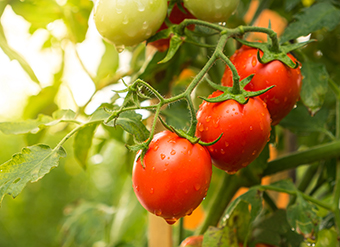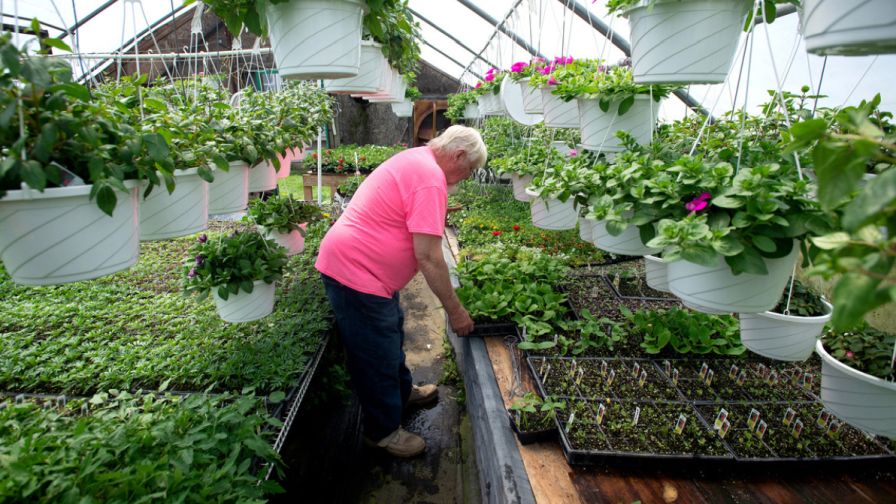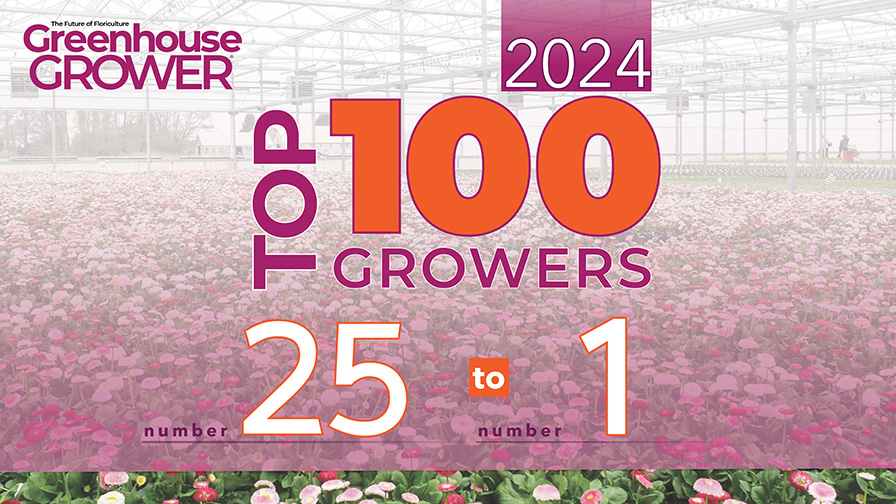How lēf Farms is Leaping Into the Leafy Greens Market
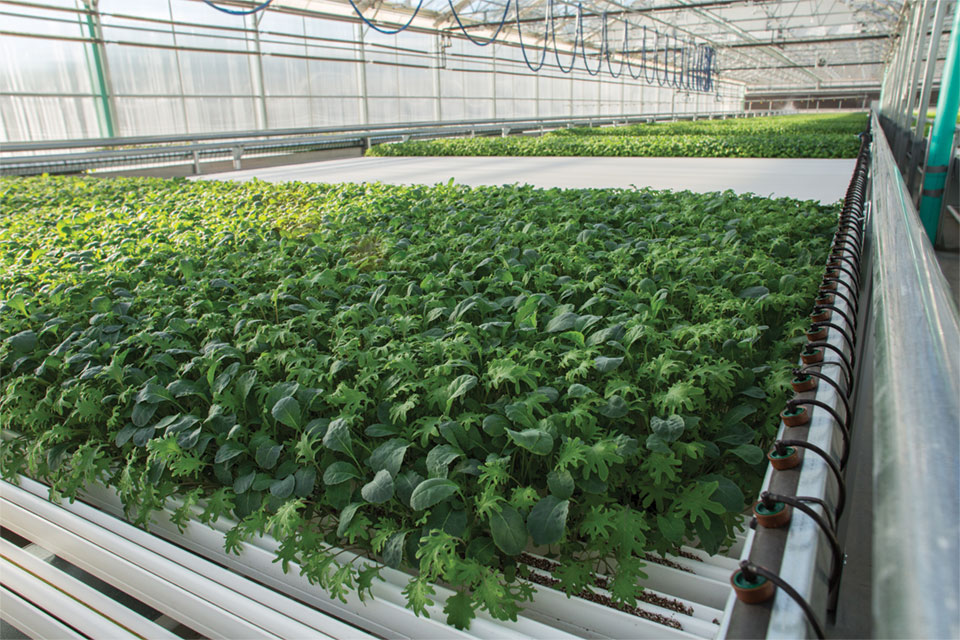 Even the most successful and innovative companies will always be looking for ways to expand and grow. Such is the case with Pleasant View Gardens in Loudon, NH, which has a rich 40-year history as a propagator of young bedding plants and one of the founders of the Proven Winners brand.
Even the most successful and innovative companies will always be looking for ways to expand and grow. Such is the case with Pleasant View Gardens in Loudon, NH, which has a rich 40-year history as a propagator of young bedding plants and one of the founders of the Proven Winners brand.
About five years ago, Pleasant View owner Henry Huntington saw that sales of bedding plants were flattening. At the same time, he was also looking for a way to make better use of Pleasant View’s greenhouses in the off season, and in particular he wanted a crop that could be turned quickly to fit into this tight off-season window.
For assistance, Huntington turned to Bob LaDue, who had spent 13 years at Cornell University researching controlled environment agriculture production before transitioning into an independent consulting role.
Huntington and LaDue quickly settled on baby greens and salad mixes as an ideal seasonal crop. Just as quickly, however, they also recognized the untapped market potential of baby greens as a year-round crop, as well as the investment they would need to make for this new venture to be successful.
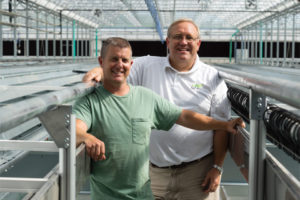
lēf Farms visionaries Bob LaDue and Henry Huntington. Photo credit: Sharon Huntington
The result of this brainstorming was the creation of lēf Farms, which is run as an independent business under LaDue’s management as Vice President and COO, along with Donald Grandmaison as Sales and Marketing Manager. Huntington is still the CEO of each company, and while lēf Farms is considered a pure start-up, Pleasant View Gardens and lēf Farms continue to share business relationships and ideas with each other.
lēf Looks Abroad for Its Automation
One thing LaDue knew from his experience in baby greens was that it is very labor intensive and needs to be mechanized.
“We immediately started looking for technology breakthroughs to make it more automated,” LaDue says. “In the last five years, companies around the world have developed systems for this, so we started traveling and looking at what they were using.”
It was a challenging process at first, because much of the technology was so new that the companies making it weren’t advertising or disclosing anything about it. LaDue says the company considered developing its own production line, but eventually selected a system from a Finland-based company called Green Automation, which had been around for about 10 years, mostly developing nutrient film technique (NFT) technology using a moving gutter system.
“Their family business is in greenhouses, but the younger family members were engineers involved in the automotive industry,” LaDue says. “They started putting their experience in automotive technology to work helping their families, and ultimately made a business out of it.”
Green Automation had just developed a way to grow baby greens on miniaturized gutters, using a chain of conveyors with centralized locations for feeding, seeding, and cutting in a head house concept.
“We went to see it at other operations, and ultimately chose it because we felt Green Automation was more mature in its thinking, particularly in the harvest end of things,” LaDue says. “We worked with them on different concepts, and they fixed things we didn’t like about the system. We were able to develop our own customized solution, and while there was a definite learning curve at the beginning, we knew we would eventually be able to create something unique to our own needs.”
One of the things lēf Farms adapted in the system was the growing medium it was designed for.
“They were using rockwool, which has its pros and cons,” LaDue says. “Seedlings don’t like it much, it is expensive to ship, and it’s not easy to get rid of when it’s done being used.”
LaDue preferred a system that could use a peat-based growing medium that could be composted instead of heading to a landfill, and Green Automation was once again willing to adapt its process.
“It allowed us to use machinery that we had already been using at Pleasant View,” LaDue says. “We were producing crops in a 120 cubic-foot bale, and it makes dealing with waste and composting roots very easy to handle. We customized their baby greens system to use a peat-based medium, and it’s working well.”
So well, in fact, that lēf Farms is able to produce 12 to 15 varieties of lettuces and other greens with two days in germination and an average of 15 days in the light before it is harvested. The entire facility encompasses 50,000 square feet of lighted greenhouse operation, with a 60-foot by 160-foot germination area underneath.
“We aren’t sacrificing light for germination,” LaDue says. “It’s a double layer system, and everything moves automatically up into the greenhouse after germination.”
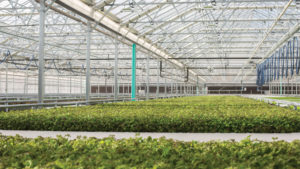
One of the main goals at lēf Farms is to deliver baby greens and mixes into stores within 24 hours of being harvested.
Maintaining the Cold Chain
Perhaps the biggest innovation that lēf Farms was able to adopt was the cooling process from harvesting to packaging.
“One of the big flaws I’ve seen in my years of consulting is that products are typically harvested in the greenhouse, or taken to a head house where they’re harvested, at the same temperature they were grown in,” LaDue says. “When you put it in a clamshell or bag it, you lock in that warm temperature, and it can take days for the core to chill down to a proper holding temperature. To get maximum shelf life, you need to get the heat out of the product as fast as possible.”
lēf Farms invested in a concept that helps the team mix, blend, and pack in a walk-in cooler. From there, packaging is done using an open-box design to efficiently remove the heat, with special plastic film laminates that are laser perforated to allow for air exchange without losing moisture.
“I’ve been to a lot of operations and have never seen anything like this,” LaDue says. “The product is precooled before it goes into the package, and the packaging design is made to post-cool it and remove heat before it leaves the loading dock.”
The end result, Grandmaison says, is a longer shelf life.
“Because we bring the crop into a cooler and initiate the cold chain prior to harvest, then harvest and bag it under cold temperatures, it doubles the shelf life of the product,” Grandmaison says. “We want to harvest today and get it into stores tomorrow. When we do this, the consumer has 15 more days to use it, which translates to less food waste and more confidence from our customers that they are getting a higher quality product that will exceed their expectations.”
Building a Higher Standard for Consumers
lēf Farms currently has two primary customer bases: local supermarket chains and restaurant/foodservice operations. “Local” is the key word, as Grandmaison emphasizes that lēf Farms is looking for companies familiar with working with local growers and developing programs around those growers. The farm-to-table movement is especially strong in New Hampshire, and the goal at lēf Farms, according to Grandmaison, is to position its salad mixes as unique in comparison to what a consumer can buy from California or even other suppliers in the Northeast.
There is often both a higher standard and a higher cost attached to locally grown produce, Grandmaison says, which means consumer education is critical.
“We’ve done well at educating our distributors and retail partners. By highlighting what makes our farm different, we can focus on value rather than price,” Grandmaison says. “For years we have come to learn that food should be cheap, especially salad greens. But the market wants something different, something healthy, nutritious, and most importantly, grown nearby. More and more people are willing to invest in that.”
Because lēf Farms is producing an edible product, there is also the food safety element to consider.
“We became GAP (Good Agricultural Practices) certified, which is important when you’re selling to any restaurant, and we also know we’ll be large enough that Food Safety Modernization Act (FSMA) rules will apply to us, so we’re gearing up for that as it evolves,” LaDue says.
A lot of the requirements involved in GAPs and FSMA overlap, so lēf Farms was quick to put many of these practices in place early in the process, from special polymer flooring to stainless-steel shelving and floor space designs to reduce the threat of bacteria.
“We are trying to stay ahead of the game as it evolves,” LaDue says.
Grandmaison also notes that food safety compliance has been key to much of the set-up at lēf Farms.
“The faster and more efficiently we can produce greens with less human contact, the more greens we can produce per square foot that are healthy and have a great chance to be clean and free of foodborne illnesses,” Grandmaison says. “Eliminating hands on the crop reduces the risk of foodborne illness significantly, which means we can then hone our system and keep our team focused and fine-tuned.”
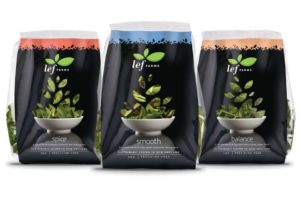 Flexibility is Key to Future Success
Flexibility is Key to Future Success
One big lesson that the team at lēf Farms has learned along the way is that there will be a constantly evolving process of adapting the technology.
“The machinery we are using is very customized, and in a few cases it might be the first time the equipment has ever been used, at least for our purposes,” LaDue says. “This means some of it will be replaced quickly, and we’ll also quickly need to learn how to use it so we can train our staff accordingly.”
As lēf Farms continues to grow, LaDue says the key to its success will be to not oversell what it is doing.
“We should eventually be able to produce 2,000 to 3,000 pounds of baby greens a day,” LaDue says. “As we get closer to this goal, we are tweaking things like seed densities and cutting heights, which should help us maximize our yields.”
Further down the chain, Grandmaison is staying on top of trends in the industry, and looking for areas where lēf Farms could potentially develop custom blends. One of the benefits of lēf Farms’ connection to Pleasant View Farms is that it has access to Pleasant View’s research and development facilities, as well as its breeder network.
“We work with a lot of seed companies and breeders on new varieties, and we can bring potential customers into Pleasant View’s facility and show them anything new on the market,” Grandmaison says. “Since it only takes us 14 days to produce a product, if there’s an opportunity to create a custom blend, we have the ability to make this happen quickly. Our mission is to introduce a new food experience, something different that keeps salad lovers engaged and captivated.”
How lēf is Marketing Its Blends
Not only is lēf Farms growing its baby greens year-round, it’s also growing its online presence with the launch of its new website, Lef-Farms.com.
The new site carries a clean, contemporary look that gives visitors all the information they need in small, bite-size portions, from short news items to where to find lēf greens, to quick summaries about each product, to the story of how the company started.
Visitors can also learn about the many benefits of hydroponic gardening, while better understanding what it means to be “farm to table.” The site also provides a summary of the key staff members at lēf that keep the operation moving forward day in and day out.
The site’s product section covers the unique blends lēf has to offer: Smooth (a blend of leaf lettuce, pac choi, mizuna, and oakleaf), Spice (a blend of arugula, mustard, cressida, mizuna, and leaf lettuce), and Balance (a blend of slightly sweet and delicate red and green kale).
For potential suppliers, the new site reviews the various markets where lēf baby greens can be found, including the grocery and hospitality markets, as well as educational facilities, institutions, and restaurants.
The site also gives retailers a quick look at some of lēf’s unique merchandising tools, from packages to signs, banners, and floor graphics.







